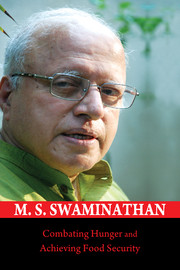Book contents
- Frontmatter
- Contents
- Foreword
- Preface
- Acknowledgements
- Abbreviations
- 1 Genesis and Growth of the Yield Revolution in Wheat
- 2 Our Agricultural Heritage
- 3 Shaping Our Agricultural Destiny
- 4 Thrust on Farm Revival
- 5 Nutri-farm Movement
- 6 Nutrition-sensitive Agriculture
- 7 Food Losses and Food Waste
- 8 Rice in Zero Hunger Challenge
- 9 Monsoon Management
- 10 Importance of Ecological Conservation
- 11 Caring for Ecology and Heritage
- 12 Conserving Biodiversity
- 13 Overcoming Hidden Hunger through Aquaculture
- 14 Biofuels – The Way to Go
- 15 Food Security
- 16 Vigilance for Sustainable Food Security
- 17 Food Security and Social Protection
- 18 Food Security and its Role
- 19 Sustaining the Livestock Revolution
- 20 Challenges in the Year of Science
- 21 Agriculture and Humanism
- 22 Fostering the Science of Science Communication
- 23 Olympic Move for Saving Children
- 24 Youth: The Agents of Change
- 25 Role of Women in Agricultural Production
- 26 Know-how to Do-how
- 27 From Bengal Famine to Right to Food
- 28 Financial Institutions and Fighting Food Inflation
- 29 Public Good Research in Agriculture
- 30 The Future of Indian Agriculture
- Bibliography
1 - Genesis and Growth of the Yield Revolution in Wheat
Published online by Cambridge University Press: 18 December 2015
- Frontmatter
- Contents
- Foreword
- Preface
- Acknowledgements
- Abbreviations
- 1 Genesis and Growth of the Yield Revolution in Wheat
- 2 Our Agricultural Heritage
- 3 Shaping Our Agricultural Destiny
- 4 Thrust on Farm Revival
- 5 Nutri-farm Movement
- 6 Nutrition-sensitive Agriculture
- 7 Food Losses and Food Waste
- 8 Rice in Zero Hunger Challenge
- 9 Monsoon Management
- 10 Importance of Ecological Conservation
- 11 Caring for Ecology and Heritage
- 12 Conserving Biodiversity
- 13 Overcoming Hidden Hunger through Aquaculture
- 14 Biofuels – The Way to Go
- 15 Food Security
- 16 Vigilance for Sustainable Food Security
- 17 Food Security and Social Protection
- 18 Food Security and its Role
- 19 Sustaining the Livestock Revolution
- 20 Challenges in the Year of Science
- 21 Agriculture and Humanism
- 22 Fostering the Science of Science Communication
- 23 Olympic Move for Saving Children
- 24 Youth: The Agents of Change
- 25 Role of Women in Agricultural Production
- 26 Know-how to Do-how
- 27 From Bengal Famine to Right to Food
- 28 Financial Institutions and Fighting Food Inflation
- 29 Public Good Research in Agriculture
- 30 The Future of Indian Agriculture
- Bibliography
Summary
2013 marks the fiftieth anniversary of the commencement of a yield revolution in wheat in India, caused by a modification in plant architecture and physiological rhythm. The wheat revolution represented a significant landmark in India's agricultural history. Its genesis and growth have been analysed earlier. Here, the steps that led to the wheat revolution in India have been briefly summarized.
The Bengal Famine (1942–43) provided the backdrop to India's independence. The average yields were below 1t/ha in wheat and rice. As a result of the tall and thin straw, the then cultivated varieties were not responding well to fertilizers or irrigation. Dr K. Ramaiah, the first Director of the Central Rice Research Institute (CRRI), Cuttack, proposed that one should transfer genes for fertilizer response from japonica to indica rice varieties. This was the beginning of the breeding of high-yielding varieties, which subsequently led to ‘the Green Revolution’. I worked at CRRI on the indica-japonica hybridization programme for sometime in 1954, before joining the Botany Division (later named by me as the Genetics Division) of the Indian Agricultural Research Institute (IARI), New Delhi. Dr B. P. Pal, Director of IARI and an eminent wheat breeder, agreed to my desire to work on semi-dwarf and fertilizer-responsive varieties of wheat using multiple research strategies, including radiation-induced erectoides mutants, on the lines of the work done by Professor A. Gustafsson in Sweden on developing the erectoides mutants of barley. Dr Pal warmly supported the proposal and mentioned that breeding wheat varieties, which can respond to fertilizer application was the need of the hour. Unfortunately, all the semi-dwarf strains the author produced by different approaches had also reduced panicle size and hence a lower yield potential.
In 1955, I learnt from Dr H. Kihara, the famous Japanese wheat scientist, that Dr Gonziro Inazuka of the Norin Experiment Station had semi-dwarf varieties with long panicles (i.e., without any pleiotropic effect) and that these were being used by Dr Orville Vogel in Pullman, Washington State, USA, in his winter wheat breeding programme. I wrote to Dr Vogel and he was kind enough to send seeds of the semi-dwarf variety Gaines. He, however, also wrote that being a winter wheat, Gaines may not flower in Delhi. He, therefore, suggested that I approach Dr Norman Borlaug in Mexico who had incorporated the same dwarfing genes in a spring wheat background.
- Type
- Chapter
- Information
- Combating Hunger and Achieving Food Security , pp. 1 - 10Publisher: Cambridge University PressPrint publication year: 2016



